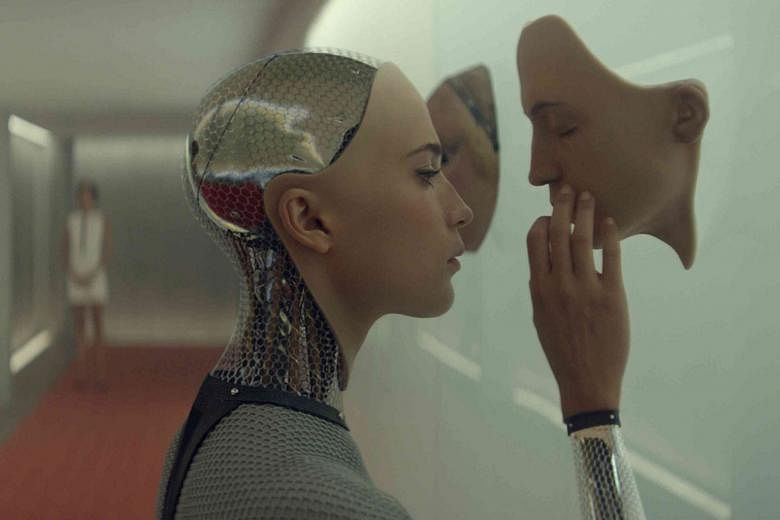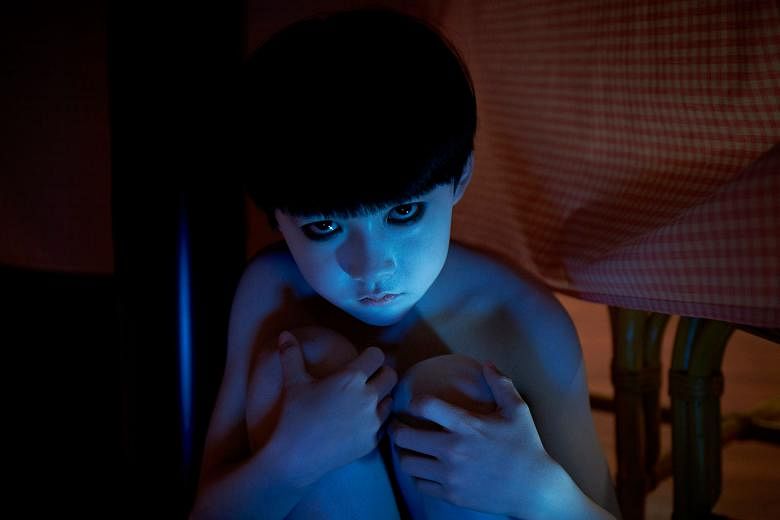There are a dozen reasons to go watch this little sci-fi chamber piece about two men and a babe- bot, but the top reason would be for the seamless intertwining of commentary and story.
In Ex Machina(M18, 108 minutes, 5/5 stars), socially inept software designer Caleb (Domhnall Gleeson) wins a trip to the remote homestead of his company's chief executive, the reclusive Nathan (Oscar Isaac), a legend in tech circles and a general misanthrope.
Caleb is told that he is there to interview Ava (Alicia Vikander), an android of Nathan's manufacture, to see if she passes for human. As the days pass, he finds that there is more to the tests - and to Ava and Nathan - than he has been told.
Novelist and screenwriter Alex Garland (The Beach, 1996; 28 Days Later, 2002; Never Let Me Go, 2010) makes his directing debut in this small-budget, low-key thriller, which he also wrote.
He extracts maximum value from limited resources. The visuals - helicopter shots of the landscape around the Nathan home and the translucent, sea anemone-like shells of the artificial humans - are as interesting as they should be and not any more.
Instead of dishing out spectacle, Garland invests energy in character, a trait he shares with makers of character-driven works of "hard" or realistic science-fiction such as Moon (2009).
Locked in the Nathan ranch, the three protagonists circle one another warily, probing weaknesses, exploiting friendships, banking on the hope that the others are who they appear to be on the surface and will do as they promise.
In a figurative sense, the trio are astronauts in a capsule at the edge of human understanding, each one not fully trusting the other two, yet relying on them to perform as programmed. Will the one with the most humanity - or the least - win the game?
Films like this are fond of hitting the pause button now and then so the leads can debate the humanity, or lack thereof, residing in The Other, whether it be an alien, a clever ape or a sentient machine like Ava.
When Caleb and Nathan argue, Garland makes sure that they do it because there is a story-driven need for it, not because, as so often happens in "smart" movies, the film-maker wants to prove he took the A-level General Paper exam.
And when they disagree, the men listen and react to each other the way real people do, rather than turn into speech-making sock puppets.
Garland prefers to insert commentary into the action, rather than let characters gab about what might happen if humans - in particular, men - had the power to create humanoid minions.
To see artificial women like the servant-bot Kyoko (Sonoya Mizuno) as she caters to Nathan's appetites is to see the robo-theme park of Westworld (1973) come to life. Except the fantasies are creepy, of fetishisation and misogyny, not of duels in the Old West.
Garland hints at more than he shows and he is not interested in firm answers. The mood here is chilly, an impression gained from the blue-grey tint of the print and from how he has taken the sombre, terse tone associated with Scandinavian directors.
Japanese creators like their blue-grey tones too, especially in the skin colour of their ghosts. In Ju On 4: The Final Curse (PG13, 91 minutes, 3/5 stars), the lad with the longest recorded tantrum comes back to tear up the suburbs, possibly for the last time, according to the title and reports from the studio. However, announcements such as these are like budget airlines' "hot deals" advertisements - not to be taken seriously.
In this sequel to last year's reboot of the Ju On franchise, Ju On 3: The Beginning Of The End, demon-tyke Toshio (Kai Kobayaki) and overprotective mum Kayako (Misaki Saisho) are now vengeful spirits, free to roam Japan.
The interesting thing about this series is that it refuses to judge who is more deserving of death. Cute or ugly, good or bad, young or old - Toshio and mum hunt them with a mechanical purpose, like spectre Terminators. Characters drop like flies - most are barely introduced before they are dealt what amounts to a fatal wrestling move.
No amount of sweetness, chastity, sisterly love, religious piety, marital loyalty or story significance will save an intended victim. With its absence of moral judgment, Ju On makes a nice, if bleak, change from the usual horror palaver.
Director Masayuki Ochiai overdoses the audience on jump scares - a common enough fault - but he also knows how to build up the chills with sound effects and slow reveals. Unlike in movies which let the audience's imagination fill in the blanks, the mother-and-son tag team here appears frequently, in close-up and in daylight, and remains no less scary for it.
If the mathematics of death are to make sense, this has to be the final chapter. The Ju On death curse visits anyone who investigates the death of a person killed by the curse. It spreads virally, in other words, so given the rate it propagates in this film, by Ju On 8, there should be no one left alive in Japan.
• All films opens tomorrow. Ex Machina is screening only at The Projector, Golden Mile Tower.


